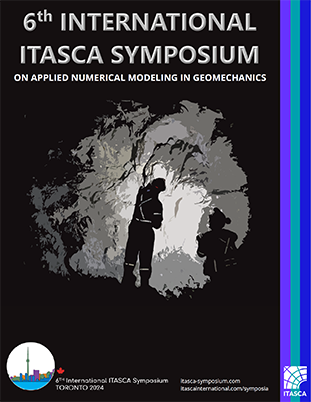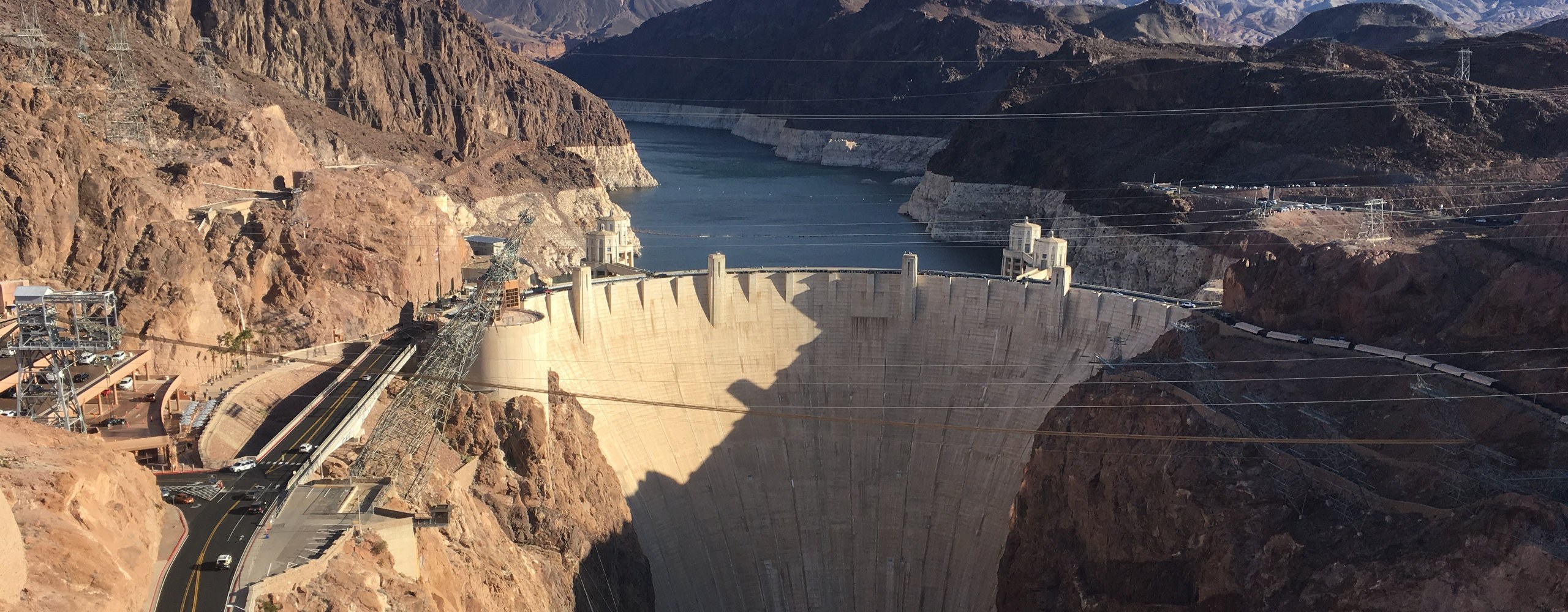Jun 2, 2024 - Jun 6, 2024
Proceedings of the 6th International ITASCA Symposium
Toronto, Canada
Editors: Jim Hazzard, Michele Nelson, Tatyana Katsaga, and Joffre Sanftenberg

Preface

ITASCA was formed in 1981 by faculty members of the University of Minnesota to provide services in rock mechanics, numerical modeling of geotechnical environments, and underground space use. Since then, ITASCA has striven to maintain a strong connection with academia and to continue promoting and engaging in research and development in these fields. Consistent with this spirit, ITASCA has organized twelve conferences (in ten countries) for users of the software they develop. To date, those conferences have been held in Australia, Austria, Canada, China, France, Germany, Japan, Peru, Spain, and the USA. The first seven symposia focused on FLAC/FLAC3D, UDEC/3DEC and PFC2D/3D independently. Beginning in 2008, the symposia brought together users of all ITASCA software in one setting where the emphasis was on the range of applications rather than individual software. After successful conferences in China (2013), Peru (2016), and Austria (2020), this year’s symposium is held at the world-famous CN Tower in the capital city of the Province of Ontario—Toronto.
Toronto is celebrated as an international centre of business, finance, arts, sports, and culture and is one of the most multicultural and cosmopolitan cities in the world. The 1960s ushered in an unprecedented construction boom in Toronto, a city quickly growing up from a regional hub to a thriving, cosmopolitan destination. Existing transmission towers were simply not high enough to broadcast radio and television signals over the tall new buildings, which bounced the signals away from their intended audience. To solve this problem—and to demonstrate the aspirations of Canadian innovation and industry—Canadian National, the Crown corporation that operated the country’s largest railway network, employed more than 1,500 workers for 40 months to build the CN Tower. Once completed, it would be the tallest tower in the world, capable of broadcasting signals far and wide across the region.
We are certain that you will enjoy your visit to Toronto, and we give all attendees the warmest welcome. As the Symposium takes place at the CN Tower, you will be sure to enjoy the heights this landmark has to offer and hopefully, if time permits you to visit some of Toronto’s other highlights, such as the Rogers Centre (home of the Toronto Blue Jays baseball team) and Casa Loma.
The Organizing Committee
PLENARY SPEAKER
Dr. Jonny Sjöberg, ITASCA International
Video
KEYNOTE SPEAKERS
Earth Resources in the 21st Century; Reflections and Projections
Prof. Charles Fairhurst, ITASCA Minneapolis
Video
Constitutive Modeling for Nonlinear Deformation Analyses in Practice
Dr. Katerina Ziotopoulou, University of California (Davis) - Civil and Environmental Engineering
Video
From Large to Small — Planetary motion to molecular motion, via wine motion
Dr. Peter Cundall, ITASCA Minneapolis
Video
The Future of Modelling: Observation Meets Analysis
Dr. Sonia D'Ambra, ITASCA Canada
Video
Fractures at all scales! Using rigid blocks to study breaking rocks
Dr. Martin Schöpfer, University of Vienna - Department of Geology
Video
30 Years of brittle damage simulation and prediction, where next?
Dr. Mark Diederichs, Queen's University – Department of Geological Sciences and Geological Engineering
Video
TECHNICAL SESSION (Extended Abstracts and Presentations)
Caverns and Large Excavations
Assessment of creep at low deviatoric stress surrounding rock salt caverns with FLAC3D
Dirk Zapf, Bastian Leuger, Feline Koerner, and Lukas Baumgaertel
01-01 | Presentation
Dynamic reinforcement strategy and design for strainburst prone excavations in an underground mine
Eugie Kabwe
01-02 | Presentation
Numerical modeling of underground excavations at the SNOWY 2.0 Power Station Complex
Nguyen Xuan-Son, Rima Ghazal, Sami Khodr, and Ivan Ching
01-03 | Presentation
Constitutive Models
Comparison of P2PSand and NorSand constitutive models for assessing static liquefaction in a tailings dam
Pascale Rousé and Andrés Panes
02-01 | Presentation
Coupled and Time-Dependent Processes
Estimating shear stress within a clay foundation using the Burgers-creep model
Mark Bancroft and Salina Yong
03-01 | Presentation
New swelling constitutive model in FLAC3D
Othman Nasir and Mahsa Bajestani
03-02 | Presentation
Numerical investigation of thermal compaction with application to the COx claystone
Mountaka Souley, Minh-Ngoc Vu, Carlos Plua, Gilles Armand, and Nathalie Conil
03-03 | Presentation
Damage Mechanics
A Subspring Network Breakable Voronoi model for rock: Grain-breakage scheme
David Potyondy and Matthew Purvance
04-01 | Presentation
Dams
Maxwell damping in FLAC3D: Verification and validation
Ethan Dawson and Zhao Cheng
05-01 | Presentation
Seismic performance assessment of dams on tailings foundation
Marjan Oboudi
05-02 | Presentation
Stability analysis of Taipinwan Dam and its fifth regular safety assessment
Yongjin Cheng, Guotao Meng, Weijiang Chu, Houlu Liu, and Xiangming Ge
05-03 | Presentation
Dynamic and Seismic Analysis
Development of a numerical modeling approach in FLAC3D to estimate critical velocity for high-speed rail
Alberto Jaen-Toribio, Alice Duley, Jun Wang, Donald Anderson, and Paul Murphy
06-01 | Presentation
Evaluation of optimal ground motion intensity measure for estimating tailings dam displacements
Nestor Bellido Añanca, Carlos Sánchez Rodríguez, and Zenón Aguilar Bardales
06-02 | Presentation
Hydraulic Fracturing
2024 PETER A. CUNDALL AWARD KEYNOTE
Rigid Body Spring Network models of drilling-induced tensile fractures
Martin Schöpfer, Mario Habermüller, Nicola Levi, and Kurt Decker
07-01 | Presentation
Machine Learning
Using site data and machine learning to improve numerical model parameterization
Chris Thielsen and Jason Furtney
08-01 | Presentation
Using Itasca Software to train machine learning surrogate models
Jason Furtney and Chris Thielsen
08-02 | Presentation
Masonry
Simulating masonry wall behavior via DEM-based computational modeling techniques
Bora Pulatsu, Jose Lemos, and Paulo Lourenço
09-01 | Presentation
Pixels to discrete blocks: An approach to generate and analyze masonry walls
Peter Griesbach, Rhea Wilson, and Bora Pulatsu
09-02 | Presentation
Material Behavior
DEM analyses of particle scaling and shear stress uniformity in direct simple shear tests
Abouzar Sadrekarimi and Shayan Hashemi
10-01 | Presentation
Effect of geometric heterogeneity on macroscopic behavior and microcracking in granite using UDEC-BBM
Jia Liu and Chengguo Zhang
10-02 | Presentation
Numerical modeling the thermal-mechanical behaviors of rocks in post-wildfire environment
Yifei Ma and Fahd Mujahid
10-03 | Presentation
Numerical simulations of loose initially uniform specimens in drained triaxial compression
David Reid, Riccardo Fanni, and Andy Fourie
10-04 | Presentation
The micromechanics of the progressive fracturing process in hard and strong polycrystalline rocks using PFC2D
Fedilberto J. Gonzalez and Mark S. Diederichs
10-05 | Presentation
Nuclear Waste
Time-dependent modeling of drifts excavated in COx claystone using FLAC3D
Frederico Lara, Lina-María Guayacán-Carrillo, Jean Sulem, Jana Jaber, Jan Cornet, Gilles Armand, and Jad Zghondi
11-01 | Presentation
Numerical Techniques and Methods
A detailed view on the process of preparing numerical models using Griddle and FLAC3D: A case of large underground mine with intersecting geologic structures
Cinthia Maldonado and Andrey Pyatigorets
12-01 | Presentation
Troubleshooting the embedded modified Cam Clay Constitutive Model in FLAC3D for reproducibility and accuracy
Yongfeng Deng, Marsheal Fisonga, Yongtao Hu, Shijiex Han, and Rennie B. Kaunda
12-02 | Presentation
Conditioning discrete fracture networks to field data
Benoît Pinier, Romain Le Goc, Quentin Courtois, Caroline Darcel, Philippe Davy, and Marco Camusso
12-03 | Presentation
DEM simulation of long railway tracks through utilizing periodic boundaries
Alireza Ahmadi, Carl Wersäll, and Stefan Larsson
12-04 | Presentation
Handling the simulation of crack injection in FLAC3D: A return of experience
Emanuele Catalano and Guadalupe Gonzalez
12-05 | Presentation
Explicit modeling of friction rock stabilizers
Fico Dio Agrensa, John Hadjigeorgiou, and Efstratios Karampinos
12-06 | Presentation
Investigating the strength and failure mechanism of hard rock pillars using Bonded Block Models
Farzaneh Hamediazad, Navid Bahrani, and Farzaneh Hamediazad
12-07 | Presentation
Selection of input properties for improved layer in plane strain stabilized excavation problems
Azneb Abdul Salam, Subhadeep Banerjee, and R.G. Robinson
12-08 | Presentation
The development of hydro-mechanical coupling method based on PFC3D with the Finite Volume Method
Jian Zhou and Jeoung Seok Yoon
12-09 | Presentation
A surrogate model for real-time slope stability analysis in three dimensions
Cristian Castro
12-10 | Presentation
Other
MPAC - Material Point Analysis of Continua
Matthew Purvance and Corne Coetzee
13-01 | Presentation
Rockfall and Debris Flow
Coupled numerical model CFD-DEM of debris flow impact on an obstacle using rigid blocks
Rime Chehade, Fabian Dedecker, Bastien Chevalier, and Pierre Breul
14-01 | Presentation
Slope Stability
Three-dimensional explicit structure representation in slope stability analysis
Annalisa Moore, Leonardo Ormazabal, Matt Purvance, and Tatyana Katsaga
15-01 | Presentation
3D numerical stability analysis of a footwall slope at the McArthur River Mine
Ke He, Mark Fowler, Felicia Weir, and Jack Stipcevich
15-02 | Presentation
Use of Itasca modeling tools and parametric models on slope stability analysis
Leonardo Ormazabal and Rodrigo Dockendorff
15-03 | Presentation
Modeling slope failure from initiation to runout geometry with FLAC3D and PFC3D: A back analysis of the Leo Failure event
Fabian Dedecker, Sacha Emam, Tatyana Katsaga, Serdar Ergun, Chad Williams, and Julia Potter
15-04 | Presentation
Soil and Rock Structure Interaction
Stochastic analysis of reinforced structures with anisotropic random soil properties
Reza Jamshidi Chenari and Richard Bathurst
16-01 | Presentation
Estimation of displacements induced on neighboring structures by the construction of the Porte Maillot station in Paris based on observations and back-analysis of the first excavation phases
Marco Camusso, Huy Tran, and Benoit Bertrand
16-02 | Presentation
Modeling of massive soil improvement based on rigid inclusions in Mexico City
Francisco Flores and Ivan Zarate
16-03 | Presentation
Tunneling
2024 PETER A. CUNDALL AWARD - Honorary Mention
Application of the CWFS method in FLAC2D to model brittle failure around the Qirehatear Diversion tunnel
Luis Gomez de Alba, Andrew Corkum, and Navid Bahrani
17-01 | Presentation
Assessing the participation of temporary support measures in an underground excavation using 3DEC
Michail Karampasis and Ilias Bakasis
17-02 | Presentation
Modeling of an adit connection to a segmentally lined tunnel in FLAC3D
Robert Adams, Michael Dutton, Peter Kottke, and Dale Brunton
17-03 | Presentation
Assessment of shaft stability using numerical modeling: the impact of tensile strength
Siavash Taghipoor
17-04 | Presentation
Underground Mining
Assessment of floor heave behavior in soft floor strata
Wanqi Zhang
18-01 | Presentation
2024 PETER A. CUNDALL AWARD - Honorary Mention
Analyzing the effect of Continuous Miner parameters on fine particle generation: A case study in a salt mine
Kamran Esmaeili and Behzad Mehrgini
18-02 | Presentation
Numerical simulation of gravity driven consolidation for backfill slurry in mine stope
Guangsheng Liu, Qinghai Ma, Lijie Guo, and Xiaocong Yang
18-03 | Presentation
Criteria for evaluation of design and mining methods using mine-scale numerical modeling
Jonny Sjöberg, Joel Andersson, Ott Oisalu, Theofanis Rentzelos, Mattias Sjölander, Mikael Svartsjaern, Jessa Vatcher, and Tristan Jones
18-04 | Presentation
A DEM-DFN method to identify connected fracture networks above mined longwall panels
Mingwei Chen, Chengguo Zhang, Ismet Canbulat, and Serkan Saydam
18-05 | Presentation
3D modeling of destress excavations at two case study mines
Shahé Shnorhokian, Owen Mickevicius, Aidan O'Heany, and Samar Ahmed
18-06 | Presentation
Geomechanical assessment of Tishinsky Underground Mine: Understanding deformation mechanisms and predicting future stability
Hao Li, Alex Turichshevor, Joffre Sanftenberg, and Tatyana Katsaga
18-07 | Presentation
Defining a seismic response index from Continuum Modeling results
Cyrille Séguineau de Préval, Amélie Ouellet, and Patrick Andrieux
18-08 | Presentation
Developing a hybrid strength model for a complex orebody in a deep hard rock mine
Pranay Yadav, Chris O'Connor, and Cinthia Maldonado
18-09 | Presentation
Numerical investigations on the impact of corrosion on the capacity of welded steel mesh
Efstratios Karampinos and John Hadjigeorgiou
18-10 | Presentation
Stability assessment for an extended stope in a case study underground mine
Adrian Ivan Santos Chauca, Shahe Shnorhokian, and Mustafa Kumral
18-11 | Presentation
3D modeling of destressed rock mass using RMR, Q', and damage factor D
Shahé Shnorhokian and Samar Ahmed
18-12 | Presentation
Use of numerical modeling and empirical approaches to optimize safety and coal recovery in an underground coal mine
Surajit Sarkar, Syed Shah Ghalib Askari, Manoj Kumar Tiwari, Indranil Saha, Piyush Srivastava, Manoj Kumar, Mayank Shekhar, Sanjay Rajoria, and Jay Aglawe
18-13 | Presentation

